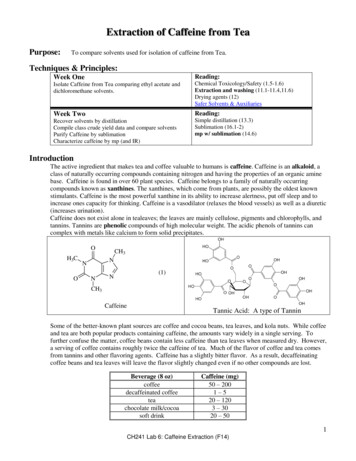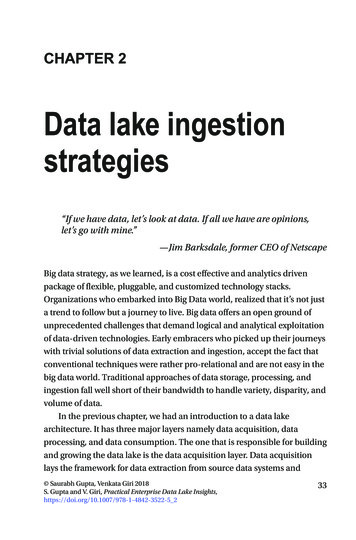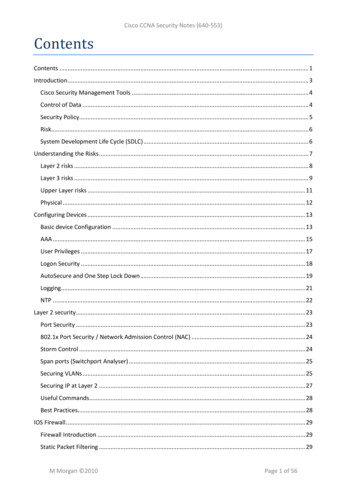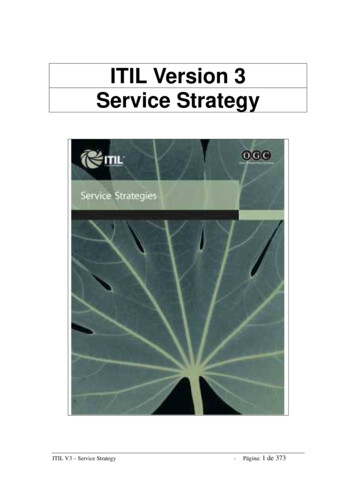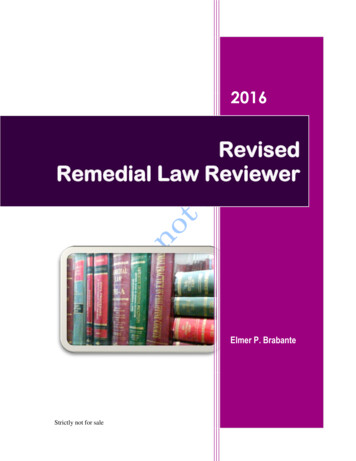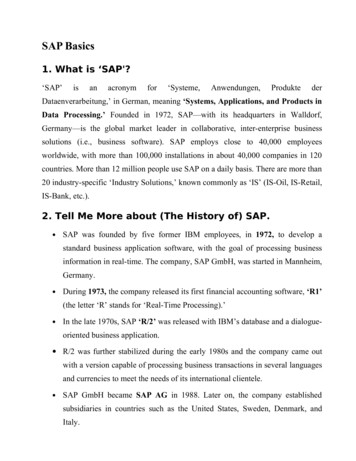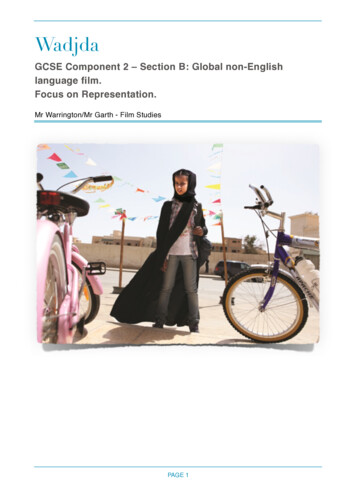
Transcription
WadjdaGCSE Component 2 – Section B: Global non-Englishlanguage film.Focus on Representation.Mr Warrington/Mr Garth - Film StudiesPAGE 1
Representation in Film: GenderWe’ve got four clips from the films below to show you and some conversations to haveabout what you understand about representation already The Girls The Boys Discussion Task:As you’re watching the clips your teacher will be talking with you about the wayboys and girls are traditionally represented.You’ll need to think about: The language used, especially insults that are used between boys and girls. The expectations and pressures created by peers and groups. The way power, however ‘soft’ it is, is used in the clips. The presentation of gender through costume and make up.Writing Task:In your books write your conclusions on representation that you’ve made fromwatching each of these clips.PAGE 2
Other Representation in FilmRepresentation is how films deal with and present gender, age, ethnicity, national andregional identity, social issues and events to an audience.As students of Film we must ask ourselves how the film we are investigating depicts thesetopics.Put simply, we must ask ourselves questions such as:How are black people represented inAmerican cinema?How are men and women depicted differently infilms of a similar genre?What are our expectations of LGBTQ characters?PAGE 3
Stereotypes and RepresentationA lot of the time we are using our prior knowledge and preconceptions based upon social norms.This essentially means that we have to understand the impact of stereotyping.A stereotype is a simplified representation of a person, groups of people or a place, throughbasic or obvious characteristics - which are often exaggerated.For example,They can be used to describe characters quickly, relying on existing audience recognition.Stereotypes are dangerous as they can lead audiences to generalise about people or places.Discussion Task:In groups/pairs try to come up with stereotyped representations of race, sexualorientation or gender that you've seen in films before.Written Task:As a class choose some of these examples and write them up into your books.PAGE 4
Using Film to RepresentFilmmakers can use a number of techniques to establish and develop characters. Their choice ofcamera techniques, acting, mise en scene, editing, lighting and sound all contribute to therepresentation of a character.Camera TechniquesThink carefully about the director’s use of camera techniques. What does this help to tell usabout the character? The use of a close up might help to accentuate an actor’s facialexpression. Likewise a high angle show might make them appear weak and powerless.Mise en sceneMise en scene refers to everything that’s put in the scene. It includes colour, costume, make upand the placement of props. What does the selection of costume tell us about a character? Doesthe composition of the shot convey information to the audience about character? How does theuse of colour in the frame contribute to the representation of character?EditingFilms are edited. Filmmakers think carefully about how the sequence of shots, pace of editingand use of editing techniques contribute to the narrative, development of characters andaudience engagement. Every scene has been painstakingly constructed. There is nothing normalor natural about the way a scene unfolds. Filmmakers agonize over every cut. Watch the scenethat you’re studying carefully and think about how editing contributes to characterdevelopment. Consider the pace of editing and whether it changes. Do the filmmakers choose tolinger on a particular shot instead of cutting away? If so, why? Are there any particular editingtechniques that stand out? What do they tell the audience about character?LightingIt’s important to remember that in most feature films, although the lighting might look normaland natural, the filmmakers have gone to great lengths to achieve a particular lighting effect.Lighting always makes a significant and meaningful contribution to the narrative. Filmmakersthink carefully about how the quality and placement of lights contributes to the narrative,character development and audience engagement. When you’re watching a scene, thinkcarefully about the use of lighting and what it tells the audience about a character.ActingEverything an actor does is part of a scripted performance which has been directed. Writingabout acting can sometimes be difficult because it requires focusing on the small details of aperformance. A simple glance or gesture actors can convey a great deal about the inner lives oftheir characters. How does an actor move? What sort of facial expressions do they use? Whattone of voice do they employ? How do these small details contribute to the development of acharacter? Always remember that actors have been directed, their performances is as deliberateand purposeful as the lighting or camera movement in a scene.PAGE 5
Writing about RepresentationThe opening scene of The Dark KnightDiscussion Task:When you watch the clip of the openingscene of The Dark Knight, think abouthow the following have been used toestablish the Joker as a villain. Costume/Make up Mise-en-scene Cinematography Acting Sound/DialogueColour code these and highlight themin the answer below Here is an example of how you might write about the establishment of The Joker as a villainin The Dark Knight:In the opening sequence of The Dark Knight, director Christopher Nolan uses a number oftechniques to establish The Joker as particularly villainous. In the early part of this sequence,dialogue is used to establish The Joker before he appears onscreen. “I heard he wears makeup,” says one of the goons, hacking his way into a switchboard. “To scare people. You know warpaint.” One of the men reveals that they’re robbing a mafia bank: “I guess the Joker’s as crazyas they say.” After shooting the bank manager, The Joker kneels down and removes his latexclown mask. Christopher Nolan uses a tight close-up of Heath Ledger’s face, accentuating thescars and grotesque make-up. The key light in this scene comes from a large window over hisright shoulder. While one side of his face is clearly illuminated, the rest is in shadow.Ledger’s voice is low and sinister as he delivers his response: “I believe whatever doesn’t killyou simply makes you stranger.” Ledger shoves a grenade into the mouth of the terrified bankmanager and leers at the camera, revealing a set of yellow teeth. This shot is also filmed fromthe perspective of the bank manager, making The Joker seem all the more sinister to theaudience.James Newton Howard and Hans Zimmer collaborated on the scores for both Batman Begins andThe Dark Knight. Their leitmotif for The Joker – a single note played on the violin whichincreases in intensity and pans rapidly from left to right, gradually joined by other discordantand distorted electronic instruments – is also used to establish the character as particularlyvillainous. Throughout this sequence a combination of camera techniques, acting, mise enscene, lighting and sound are all used to establish The Joker as a villain.PAGE 6
Wadjda: FactfileDirected byHaifaa al-MansourProduced byGerhard MeixnerRoman PaulWritten byHaifaa al-MansourStarringWaad MohammedReem AbdullahAbdulrahman al-GuhaniMusic byMax RichterCinematographyLutz Reitemeier (de)Edited byAndreas WodraschkeProduction CompanyRazor Film Produktion GmbHNorddeutscher RundfunkBayerischer RundfunkRotana TVHighlook Communications GroupDistributed byKoch Media (Germany, all media)Release date31 August 2012 (Venice Film Festival)Running time98 minutesCountrySaudi ArabiaGermanyUnited Arab EmiratesJordanNetherlandsUnited StatesLanguageArabicBox office 14.5 million*(made loads of money in Italy, like 9 million)PAGE 7WaadMohammed asWadjdaReem Abdullahas Wadjda’sMotherAbdulrahman alGuhani asAbdullah
Context of Saudi ArabiaWhere is Saudi Arabia?Saudi Arabia is a desert countryencompassing most of theArabian Peninsula in what iscommonly known in WesternCountries as ‘the Middle East’,with Red Sea and Persian(Arabian) Gulf coastlines.Known as the birthplace ofIslam, it’s home to the religion’stwo most sacred mosques andalso contains the burial place ofthe prophet Muhammad.Timeline of Important Historical Events1932 September - The areas controlled by2001 11 September - 15 of the 19 hijackersAbd-al-Aziz are unified under the nameinvolved in attacks on New York andKingdom of Saudi Arabia and Abd-al-AzizWashington are Saudi nationals.is proclaimed King.2001 December - King Fahd calls for the1938 - Oil is discovered and productioneradication of terrorism, saying it isbegins under the US-controlled Aramcoprohibited by Islam; government takes the(Arabian American Oil Company).unprecedented step of issuing ID cards to1972 - Saudi Arabia gains control of awomen.proportion (20%) of Aramco, lessening US2002 May - Revised criminal code includescontrol over Saudi oil.ban on torture and right of suspects to1980 - Saudi Arabia takes full control oflegal representation, but rightsAramco from the US.campaigners say violations continue.1999 October - Twenty Saudi women2003 September - More than 300 Saudiattend a session of the government’sintellectuals - women as well as men - signConsultative Council for the first time.petition calling for far-reaching politicalreforms.PAGE 8
2005 February-April - First-ever2012 Saudi Arabia agrees to allow itsnationwide municipal elections. Womenwomen athletes to compete in thedo not take part in the poll.Olympics for the first time, against the2009 King Abdullah sacks head ofbackground of speculation that the entirereligious police, most senior judge andSaudi team might be disqualified oncentral bank head in rare governmentgrounds of gender discrimination.reshuffle. Also appoints country's first2013 February - King Abdullah swears inwoman minister.30 women to the previously all-male Shura2011 February - King Abdullah announcesconsultative council - the first time womenincreased welfare spending, as unresthave been able to hold any political office.continues across Arab world.2015 November - Women stand in2011 June - Saudi women mount symbolicmunicipal elections for first time, 20 areprotest drive in defiance of ban on femaleelected.drivers.2017 February - The Saudi Stock Exchange2011 September - King Abdullahand a major bank name women as theirannounces more rights for women,chief executives.including the right to vote and run in2017 September - Laws are passed whichmunicipal elections and to be appointed towill allow women to drive from June 2018.the consultative Shura Council.Saudi Arabia was the last country in theA woman is sentenced to 10 lashes afterworld that banned women from driving.being found guilty of driving, in the first2017 The Crown Prince of Saudi Arabialegal punishment for violating the ban onannounces the country will seek a returnwomen drivers. King Abdullah overturnsto ‘moderate, open Islam’.the sentence.Task: Read Wadjda Context Handout 1 - BBC report on women driving.Read and Highlight men’s attitude to women/religious attitudes/progressiveattitudes using a three colour key.Task: Watch the video about ‘ten things banned in Saudi Arabia’. Pay attention tocinema and photography sections, your teacher will pause for you to make notes asa class.Task: Watch the introduction to American action film The Kingdom. Based on thisclip what do you think people who live in America and the Western World knowabout Saudi Arabia? Why would they show this at the start of a film based in thecountry?PAGE 9
What is Saudi Arabian Cinema?There is, at the time of writing in 2017, only one cinema in Saudi Arabia. TheIMAX in Khobar. This is located in a science and technology centre andwhilst it is public, it shows primarily nature documentaries optimised forIMAX viewing.Since 1979 all cinemas have been closed due to a rise in Islamicfundamentalist activism. Prior to that law being passed there were cinemasin the country. In recent years there has been the suggestion that cinemascould re-open in the country due to the Vision 2030 initiative to modernisethe society. This has not been a universally popular movement.So, whilst there have been films, like The Kingdom and other Middle Easternfilms, that have had story sections set in Saudi Arabia - none of them wereactually filmed in the country. Usually countries like UAE and Abu Dhabidouble as Saudi Arabia in these films because of the similar ‘desert’ look.Research Tasks:Find five facts about Saudi Arabian laws (try to find out about laws to do withcinema or photography).Find a recent news story about Saudi Arabia, reduce it to a page and highlight keypoints ready to discuss.Find a review of Wadjda that you understand, highlight any section about howwomen and girls are shown in the film and what their life is like in Saudi Arabia.PAGE 10
Making WadjdaObstacles & OpportunitiesThe director of Wadjda, Haifaa alMansour, had to overcome a lot ofobstacles to make the film. Not leastbeing a woman herself she famouslyhad to direct exterior scenes from theback of a van.Another strictly monitored ‘rule’ inSaudi Arabia is the ‘Guardian’ systemwhere women are expected to obey theorders and directives of their appointedmale ‘guardian’ (a husband, father, brother, uncle). This isn’t a law, as such, but is such astrongly held custom that it essentially functions as a law. Below is a list of things awomen needs permission from her male ‘guardian’ to do: Get married or divorced Travel Get an education Get a job Open a bank accountHaifaa al-Mansour has repeatedly stated that Wadjda isn’t intended to upset or angerconservatives in the country. She isn’t trying to rage against the machine, which should beclear from the attitude and feeling of her film. She states:“Women cannot do business without the consent of a male and all that. It is very importantto give women and men some space to be who they are. But for me it is very
31 August 2012 (Venice Film Festival) Running time 98 minutes Country Saudi Arabia Germany United Arab Emirates Jordan Netherlands United States Language Arabic Box office 14.5 million* (made loads of money in Italy, like 9 million) PAGE 7 Waad Mohammed as Wadjda Abdulrahman al-Guhani as Abdullah Reem Abdullah as Wadjda’s Mother. Context of Saudi Arabia Where is Saudi Arabia? Saudi


